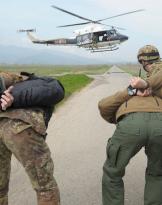The profound evolution that our society has had in the last twenty years has led to changes in habits and behavior. If our grandparents were born and died in a certain place, remember the proverb "wives and oxen of your countries", today travel and travel for thousands of kilometers is a custom. The generation of fifty-year-olds grew up with televisions (the smallest of the family got up to change channels), while their children are digital natives, tablet, smartphone and computer they are instruments of daily life. The boys of the new millennium sometimes live in the border line between the reality of adolescent falling in love and that of a "virual" reality that exposes them to risks and threats that are difficult to perceive from previous generations.
The introduction of information technology in the country has not been accompanied by a process of literacy and collective awareness, thus losing a great opportunity to start a process of modernization. One of the biggest pitfalls to which adolescent boys are subject today is the cyberbullying. That saying that all the mothers have taught us "do not take candy from a stranger" today should certainly be reconsidered and, perhaps, reformulated in terms of "cybercarelle".
The term cyberbullying It was coined for the first time by the Canadian professor Bill Belsey1 in the 2002 to define a widespread phenomenon in the western world. In the Anglo-Saxon countries it was defined as "that form of voluntary and repeated prevarication, implemented through an electronic instrument, perpetuated against an individual or a group with the aim of hurting the victim of such behavior, who is unable to defend himself"(Smith et al., 2006).
In Italy the Parliament has given the green light to the provisions against the phenomenon of the so-called cyber-bullying about a year ago, with the 29 Law May 2017 n. 71 on "Provisions for the protection of minors for the prevention and control of the phenomenon of cyberbullying".
The law defines the "cyberbullying" as: "any form of pressure, aggression, harassment, blackmail, injury, denigration, defamation, identity theft, alteration, illicit acquisition, manipulation, unlawful processing of personal data to the detriment of minors, made electronically, and the dissemination of content on line also concerning one or more members of the minor's family whose intentional and predominant purpose is that of isolating a minor or a group of minors, implementing a serious abuse, a harmful attack, or putting them in ridicule ".
The law (art 1) "the aim is to counter the phenomenon of cyberbullying in all its manifestations, with preventive actions and with a strategy of attention, protection and education towards the children involved, both in the position of victims and in that of those responsible for illegal activities. , ensuring the implementation of interventions without distinction of age within the educational institutions ..."
It is stated in the framework of the educational institutions in the art. 4 that "each educational institution within its own autonomy, identifies among the teachers a contact person with the task of coordinating the initiatives of prevention and contrast of cyberbullying, also making use of the collaboration of police forces as well as associations and youth gathering centers present on the territory".
In the art. 7 of the law introduces the concept of "warning": "Until there is a complaint for one of the offenses referred to in Articles 594, 595 and 612 [..] by minors over the age of 14 in respect of another minor, the warning procedure is applicable. For the purpose of the warning, the commissioner summons the child together with at least one parent or another person with parental responsibility. "
The law makes no reference to bullying. as confirmed by the Senator Francesco Palermo's law draftsman2, in order not to make it too broad and therefore ineffective, hence the importance of distinguishing which types of behavior belong to one or the other category of activity, made simpler by the comparison table drawn up by the MIUR3.
|
Bullying |
Cyberbullying |
|
Only students of the class and / or of the Institute are involved; |
Boys and adults from all over the world can be involved; |
|
Generally only those who have a strong character, able to impose their power, can become a bully; |
Anyone, even those and victims in real life, can become cyberbullies; |
|
The bullies are students, classmates or institutes, known by the victim; |
Cyberbulbs can be anonymous and solicit the participation of other anonymous "friends", so that the person does not know who he is interacting with; |
|
The actions of bullying are told to other students of the school in which they took place, they are limited to a specific environment; |
The material used for cyberbullying actions can be spread all over the world; |
|
Bullying actions take place during school hours or on the way home-school, school-house; |
Aggressive communications can take place 24 hours on 24; |
|
School or class group dynamics limit aggressive actions; |
Cyberbulbs have ample freedom to be able to do online what they could not do in real life; |
|
The bully needs to dominate in interpersonal relationships through direct contact with the victim; |
Perception of invisibility by the cyberbulb through actions that lie behind the technology; |
|
Obvious reactions from the victim and visible in the act of bullying; |
Absence of visible reactions from the victim that do not allow the cyberbully to see the effects of their actions; |
|
Tendency to shirk from responsibility by bringing violence actions to a joking level. |
Doubling of the personality: the consequences of their actions are attributed to the "user profile" created. |
The 6 February 2018 in about 100 countries was held on Safer Internet Day4, the World Network Security Day established by the European Commission with the aim of promoting a safer and more responsible use of the web and digital technologies, especially among children and young people. During the meeting4 held in Rome. Organized by the Moige and the State Police, under the patronage of the Ministries of Education and Labor and the ANCI, data on cyberbullying in Italy were presented, on 354 reports of minors treated in the 2017 by the Police Postal, 59 have involved the spread of child pornography and 116 cases of insults, harassment and threats.
Almost a year after the entry into force of the law we can only appreciate its effectiveness even if much remains to be done, sharing in particular the re-educational spirit and particularly appreciating those aspects aimed at empowering those responsible for offenses such as institute of warning.
Proof of this is the recent episode of warning in the province of Latina5 where the agents of the Commissariat of Terracina, after a survey carried out in collaboration with the head teacher of a secondary school, have executed the warning of the Quaestor of Latina for "cyberbullying" against a 15enne for cyber bullying and have taken steps to eliminate from the net a false profile and the material used to offend a classmate. A reflection should be made on the dissemination of the smartphone, tablet e laptop that are in fact instruments of everyday life but that require a conscious use by the adolescents, given the difficulty in managing images, films that once "posted" on the Internet, can become an instrument of offense losing control to realize the scope of the phenomenon worldwide UNICEF6 has published the "The State of the World's Children 2017" in which the opportunities are highlighted, but also the risks to which digital technologies can expose teenagers.
1 Cyberbullying from the first definitions to the most recent data by Eddy Chiapasco Mirko Cario












